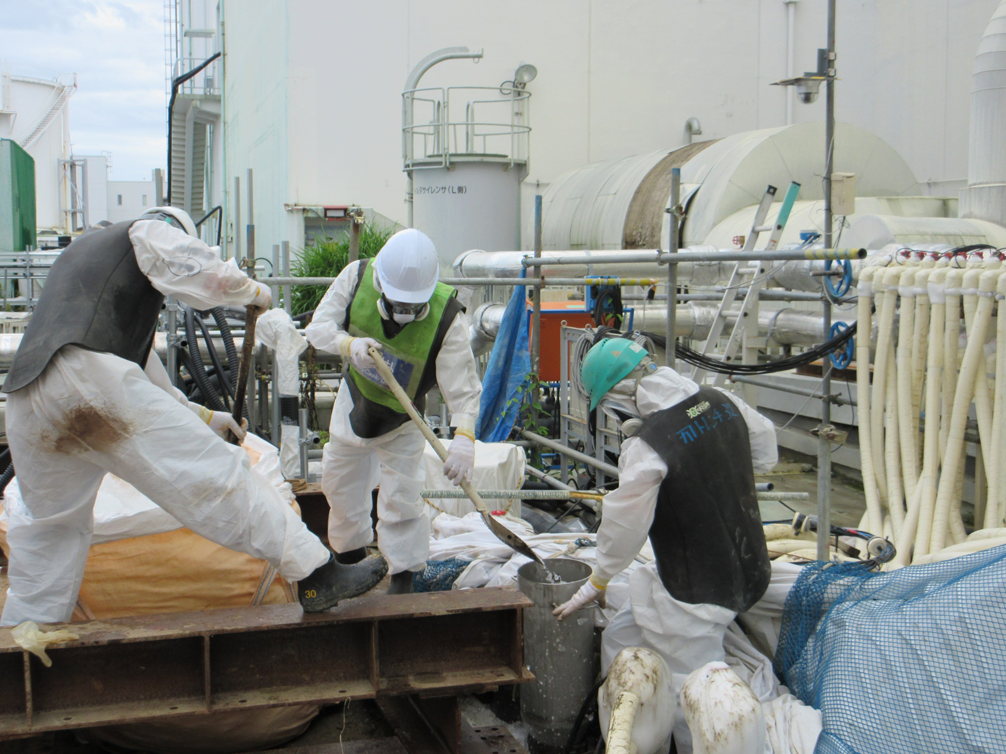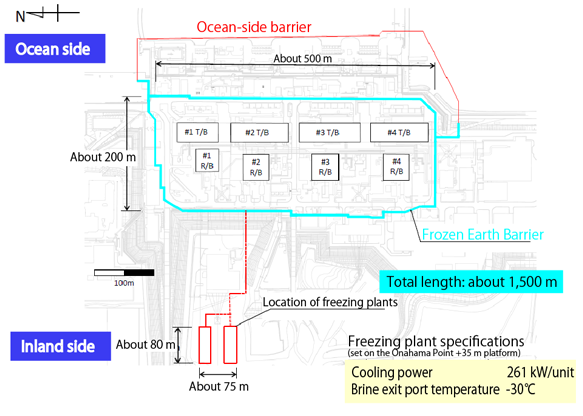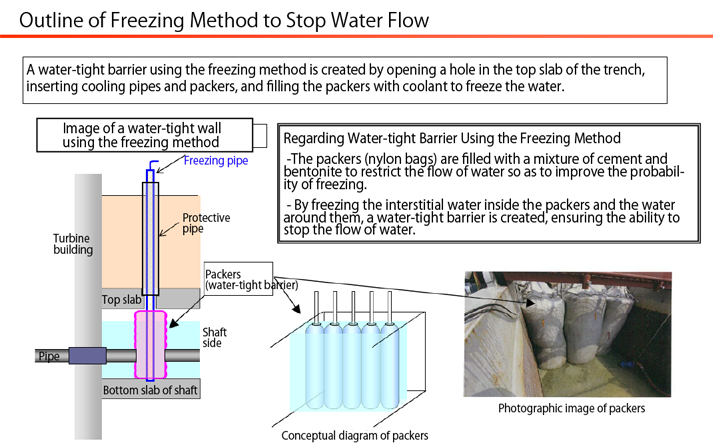Contaminated Water Woes at Fukushima Daiichi Is Seepage Control Possible Using a “Frozen Earth Barrier”? Nuke Info Tokyo No. 162
 |
| The struggle with contaminated water (Photo by TEPCO) |
The Battle to Contain Contaminated Water
The Fukushima Daiichi Nuclear Power Station (FDNPS) has serious water contamination problems. Water injected to cool the nuclear fuel has picked up radioactive contaminants, and continues to increase in volume due to intrusion of groundwater. About 1000 tons per day of groundwater flows into Fukushima Daiichi Units 1 to 4 reactors, of which about 400 tons enters the buildings. Part of the other 600 tons comes into contact with sources of pollution in the trenches, but is released into the ocean as polluted water. Under current circumstances, continually increasing amounts of polluted water are being stored in above-ground tanks. At present, the tanks’ capacity is 550,000 tons, but there are plans to ensure a future capacity of one million tons.
The Japanese government and TEPCO have stated three fundamental principles for dealing with the contaminated water.
1. Remove the sources of contamination
2. Prevent water from approaching the sources of contamination
3. Prevent contaminated water from leaking
Under the second principle, in May 2014, they began using a new “groundwater bypass” system, in which they collect groundwater from the inland side of the site (the west side), test it for radioactivity, and then release it into the ocean so as to reduce the amount of groundwater entering the buildings. However, even if the groundwater bypass system works well, it only reduces the amount of water entering the buildings by 10 to 100 tons/day.
 |
| Fig. 1 Position of impervious Frozen Earth Barrier on the inland side. |
Frozen Earth Barrier Establishment and Problems
The chief countermeasure under the second and third principles is the establishment of an impervious wall by means of freezing the soil, the “frozen earth barrier” in the title of this article. The plans for this frozen earth barrier, which the government and TEPCO are expecting to be effective, involve burying cooling pipes to a depth of 30 m and at intervals of 1 m so as to surround the Unit 1 to 4 reactor buildings, and freezing the groundwater together with the soil. The total length of the wall will be about 1,500 meters, and to freeze the soil, 30 freezing plants are to be established, each consuming 261 kW of electric power. Construction began in June 2014.
As Fig. 1 shows, even if they try to surround the underground parts of the buildings with a barrier, there are still trenches (tunnels) passing between the buildings with plumbing and cables connecting them. In the trenches of Units 2 and 3, water has accumulated with high concentrations of radioactive contaminants, and this has been called the biggest danger at the FDNPS. TEPCO considers that this radioactive material accumulated at the time of the nuclear accident, so the total amount is about 11,000 tons (5,000 tons at Unit 2 and 6,000 tons at Unit 3), and it is reported to contain cesium 137 plus 134 isotope concentrations totaling 109 Bq/L. It goes without saying that it also contains various other radionuclides in addition to cesium.
In order to isolate the buildings by surrounding them with a frozen earth barrier, the contaminated water in the trenches needs to be removed. The government and TEPCO are using the following procedures to try to remove the contaminated water from the trenches.
ⅠFreezing the junctions of the trenches with the buildings to stop the water
ⅡTransferring out the contaminated water in the trenches
ⅢFilling the trenches and shafts by packing them with a mixture of gravel, plastic mortar, grouting and concrete.
ⅣThawing and filling in the junctions of the trenches with the buildings
 |
| Fig. 2 Measures to remove contaminated water – outline of freezing method to stop water flow |
The method used for procedure I is to introduce cooling pipes and packers (watertight barriers) through a hole in the upper part of the trench, fill the packer with coolant and freeze it (Fig. 2). The temperature of the coolant reaches as low as minus 30 – 40ºC. At present, TEPCO is trying to stop the flow of water by freezing it in the junction between the Unit 2 turbine building and the trench, but it is not going well. For example, for the cross section area of 4.4 m by 5.7 m of the junction of Trench A with the Unit 2 reactor, they have installed 19 cooling pipes and are trying to freeze it, but as of the end of August, changes have been observed in the level of contaminated water within the turbine building. In other words, the contaminated water is not completely frozen.
The method originally involved freezing the interstitial water in the ground, and it was clear even prior to implementing this strategy that there was no proof that the water itself would freeze, so there were doubts about the ability to freeze large amounts of contaminated water in the trenches using this method.
TEPCO compared the demonstration tests with the actual execution and identified two factors in the failure of the latter to freeze the water. Firstly, fluctuations were occurring in the water level in the trench due to fluctuating water levels in the building, and secondly, insufficient adhesion of the packers with each other due to issues with drilling precision in the on-site execution.
From the end of July, TEPCO started injecting ice and dry ice into the trench. As of August 26, they had injected about 558 tons of ice and about 12 tons of dry ice. A temperature decrease in the trench is confirmed to have occurred as a result, so a certain degree of effectiveness has been recognized, but problems have arisen, such as condensation freezing in the observation port, blocking the hole and making it impossible to insert the observation camera. In addition to these measures, they have begun considering increasing the number of cooling pipes and introducing sealant into the gaps to restrict the flow of water. The goal is to remove the contaminated water and complete filling operations by the end of fiscal 2014 by implementing these countermeasures.
Why Did They Choose a Frozen Earth Barrier?
A comparison was made of three means of creating an impervious barrier: frozen earth, clay, and gravel (macadam) diaphragm walls, and the frozen earth barrier was selected on that basis. Tatsuya Shinkawa, head of METI’s Nuclear Accident Response Office at the Agency for Natural Resources and Energy, explained, “Our decision was based on the high degree of impermeability and effectiveness at restricting underground water flow, the short construction time, high feasibility, space considerations of width of the impervious barrier needed to surround the buildings, and the fact that the amount of underground water to be handled was small, making it relatively easy to control water levels underground.”
While extolling the superiority of the frozen earth barrier, METI sources state, “These efforts to surround the buildings on the inland side over a long period with an impervious barrier using the frozen earth method are a challenge with no precedent anywhere in the world, and involve many technological problems. This should therefore not be left to the company alone, but the government should take the initiative, consider aiding R&D, including that of other means of control, and support its actualization.” This indicates active support from the government.
The government is justifying financial aid to TEPCO using the pretext of a need to support R&D because frozen earth barriers constitute an incomplete technology. If the company had chosen a proven method, there would have been no pretext for financial assistance. Could this have been the decisive reason for their choice of the unproven frozen earth barrier method?
The government is bearing the 32 billion yen cost of the frozen earth barrier as the showpiece of its water contamination countermeasures. To invest lots of tax money and energy in an ineffective enterprise, while pointlessly increasing workers’ exposure to radioactivity, is unforgivable.
(Nobuko Tanimura, CNIC)
